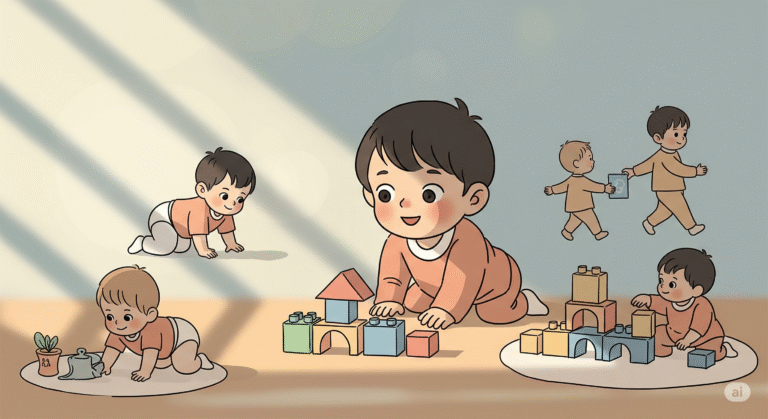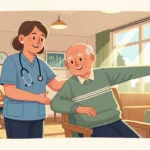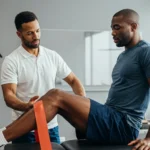Developmental Milestones: Unraveling the Mystery of Child Development

It’s truly incredible to witness the journey of our little ones. Just a few short years ago, they were tiny bundles, full of unknown potential. Now, they’re crawling, walking, talking, and constantly surprising us! The process of child development is often described as one of life’s most magical experiences, a continuous unfolding of new skills and abilities.
While every child is wonderfully unique and develops at their own pace, there are certain common child developmental milestones that serve as a valuable guide. These milestones aren’t strict deadlines, but rather a framework that helps us understand if a child is progressing typically, or if there might be an area where they could benefit from a little extra support.
In this blog, we’ll embark on a journey to explore some of these key developmental milestones for children, categorized for clarity. We’ll also highlight important signs that might suggest a need for professional advice, ensuring you feel empowered and informed every step of the way. Plus, stay tuned for a special Busy Mom’s 1-Page Cheat Sheet: My Motor Milestone Chart to make tracking even easier!
Table of Contents
ToggleWhat Exactly Are Developmental Milestones?
Developmental milestones are observable behaviors or physical skills that typically emerge within a specific age range. Think of them as signposts along your child’s growth journey, indicating the acquisition of new abilities. They provide a general idea of the skills children are expected to develop and are crucial for identifying any potential developmental delays early on.
These milestones are broadly grouped into four main categories:
Physical (or Motor): These relate to your child’s ability to move their body, including gross motor skills (large movements like crawling, walking) and fine motor skills (small movements like grasping, writing).
Emotional & Social: This category covers how children interact with others, express feelings, and understand social cues.
Language & Communication: Encompassing everything from cooing and babbling to forming words and understanding instructions.
Cognitive: This refers to your child’s thinking skills, problem-solving, learning, and understanding the world around them.
An Important Reminder: Please remember that every child is an individual, and their development will unfold uniquely. Just because your child hasn’t reached a specific milestone exactly within the age range provided doesn’t automatically mean there’s a problem. However, if you do have any concerns about your child’s development, the best course of action is always to seek professional advice from a qualified health professional, such as your GP, a Paediatric Physiotherapist, or a Paediatrician.
Key Developmental Milestones: Your Guiding Star
Below, we’ll outline some key child developmental milestones. Use this as a helpful guide, but not a rigid rulebook.
0-2 Months
Emotional Milestones: Baby smiles back when smiled at or spoken to; looks at caregiver’s face; calms down when picked up or upon hearing caregiver’s voice.
Cognitive Milestones: Tracks caregiver’s movement with eyes; looks at a toy for a few seconds; startled by loud sounds.
Language Milestones: Smiles when happy; cries to communicate needs.
Physical Milestones: Developing head control; holds head up on tummy / in supported sitting; turns head from side-to-side and pushes through forearms on tummy; when held in standing, puts weight through feet.
3-5 Months
Emotional Milestones: May smile to get your attention; makes noises when spoken to; turns head to look at sound origin; generally happy.
Cognitive Milestones: Plays with own hands.
Language Milestones: “Coos”; makes different sounds to indicate different needs.
Physical Milestones: Improved head control; while lying on back, brings feet and hands to mouth; when on back, swings at toys using arms; uses hands to stay balanced in sitting; holds onto toys in hand when given, transfers toy between hands; rolls tummy to back.
6-7 Months
Emotional Milestones: Responds to emotions and tone of voice of others; enjoys looking at reflection in mirror; distinguishes familiar faces from strangers.
Cognitive Milestones: Reaches for toys; explores objects with mouth.
Language Milestones: Laughs and giggles; babbles.
Physical Milestones: Pushes through hands and pivots on tummy; starts to sit with little help / hand support; reaches for toys; in side sitting, comfortably plays with toys; in unsupported sitting, plays with hand-held toy; from a seated position, shifts weight from bottom to bottom and breaks fall with open hand; rolls in both directions; bounces in standing.
8-9 Months
Emotional Milestones: Cries when primary caregiver is not within visual field; may be fearful around strangers / unfamiliar environments; can show different expressions to express feelings (e.g., angry, surprised); smiles when playing peek-a-boo.
Cognitive Milestones: Starts to recognize own name when called; imitates others’ movements; makes sounds by knocking 2 objects together; searches for toys that have been dropped.
Language Milestones: Imitates sounds; makes longer sounds.
Physical Milestones: Emerging pincer grip; picks up smaller objects with thumbs and fingers; transitions sitting to tummy and tummy to sitting; in unsupported sitting, visually tracks objects and reaches for toys without falling; gets in and out of sitting position; pulls to stand, and stands whilst holding on; emerging cruising (taking a few steps while holding on); creeping / crawling emerges.
10-12 Months
Emotional Milestones: Plays simple games with you.
Cognitive Milestones: Crawls towards toys; releases toys into a container; actively searches for something they see you hide.
Language Milestones: Uses gestures to communicate own needs; looks to where you are pointing; continues to babble with speech intonation; uses 1-2 word vocabulary; understands simple words and phrases (e.g., “no,” “come here”); calls “mama” or “dada.”
Physical Milestones: Can crawl over parents’ legs; pulls to stand, leading with one leg followed by the other; independent standing for ~5 seconds; in standing while holding on, can pick up objects from the ground; cruising; takes a few independent steps.
12-18 Months
Emotional Milestones: Shows affection (e.g., hugs, kisses); plays further away from you comfortably whilst primary carer is still in vicinity.
Cognitive Milestones: Helps during dressing time; feeds / drinks by themselves.
Language Milestones: Uses ~10 words; understands ~50 words; can identify 1-2 body parts; points to show their wants; follows simple instructions.
Physical Milestones: Grasps onto pencil with fist (Palmar grasp); rolls ball in sitting; climbs on/off furniture without assistance; crawls up/down stairs; plays in tall knees unsupported; stands from floor unsupported; independent standing for ~10 seconds; in standing, can pick up objects from the ground unsupported; walks independently for moderate distances (~300m) and seldom falls; walks backward whilst pulling toy.
19-24 Months
Emotional Milestones: Notices other’s emotions.
Cognitive Milestones: Completes tasks requiring 2 hands simultaneously; uses a spoon during mealtimes.
Language Milestones: Uses ~50 words in 2-word phrases; uses gestures (e.g., wave, nod, point); points to answer “Where is?” questions; understands action words (e.g., “sit down”); can identify 3-5 body parts; imitates new words and understands them quickly; names objects; understands simple pronouns (e.g., me, you).
Physical Milestones: Kicks a ball; stands up on tippy toes; running emerges; climbs up stairs independently whilst holding on.
3 Years
Physical Milestones: Uses both hands to open a jar; uses a fork during mealtimes; can complete threading tasks (e.g., beads on a string); dresses/undresses some clothing independently; runs well; walks up/down stairs independently with alternate feet; jumps with both feet; hopping emerges; pedals tricycle.
4 Years
Physical Milestones: Can undo buttons; grasps onto pencil with fingers and thumb (Tripod grasp); hops and skips; single-leg balance for a few seconds; jumps over small obstacles; changes direction when running without losing balance; catches a ball.
5 Years
Physical Milestones: Can redo buttons; single-leg balance for ~10 seconds.
Conclusion
Understanding child developmental milestones is an invaluable tool for parents. It helps you monitor your child’s progress, celebrate their achievements, and identify early on if they might benefit from additional support. If you ever find yourself concerned about your child’s development, please do not hesitate to reach out.
Early intervention is absolutely essential to effectively support your child’s development and help them reach their full potential. Our dedicated paediatric physiotherapists are experts in conducting thorough developmental assessments and creating tailored plans to address any concerns.
Don’t hesitate—book in for your FREE 1-HOUR PHYSIOTHERAPY SESSION NOW!
If you found this blog post helpful, you might also enjoy reading: 5 Reasons Why You’ll Love Mobile Paediatric Physiotherapy Service.
And for your ultimate convenience, you’re in for a treat with our free resource: “A Busy Mom’s 1-Page Cheat Sheet: My Motor Milestone Chart.” Download it here to easily track your child’s physical development!
Health Next Door, we bring mobile physiotherapy to your doorstep, ensuring a patient-centric approach that prioritizes your needs and goals. Our experienced physiotherapists assess your condition and create a personalized therapy plan, helping you recover in the comfort of your home with expert care tailored just for you. With our comprehensive mobile physiotherapy services, you get professional treatment for pain relief, injury recovery, and mobility improvement—all without leaving your home. Experience convenient, high-quality care designed to fit your lifestyle.
View All Articles
